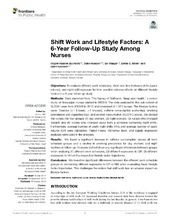| dc.description.abstract | Objectives: To evaluate different work schedules, short rest time between shifts (quick returns), and night shift exposure for their possible adverse effects on different lifestyle factors in a 6-year follow-up study. Methods: Data stemmed from “The Survey of Shiftwork, Sleep and Health,” a cohort study of Norwegian nurses started in 2008/9. The data analyzed in this sub-cohort of SUSSH were from 2008/9 to 2015 and consisted of 1,371 nurses. The lifestyle factors were: Exercise (≥1 h/week, <1 h/week), caffeine consumption (units/day), smoking (prevalence and cigarettes/day), and alcohol consumption (AUDIT-C score). We divided the nurses into four groups: (1) day workers, (2) night workers, (3) nurses who changed toward, and (4) nurses who changed away from a schedule containing night shifts. Furthermore, average number of yearly night shifts (NN), and average number of quick returns (QR) were calculated. Paired t-tests, McNemar tests, and logistic regression analyses were used in the analyses. Results: We found a significant increase in caffeine consumption across all work schedule groups and a decline in smoking prevalence for day workers and night workers at follow-up. Analyses did not show any significant differences between groups when analyzing (1) different work schedules, (2) different exposures to QR, (3) different exposures to NN on the respective lifestyle factor trajectories. Conclusion: We found no significant differences between the different work schedule groups or concerning different exposures to QR or NN when evaluating these lifestyle factor trajectories. This challenges the notion that shift work has an adverse impact on lifestyle factors. | en_US |

